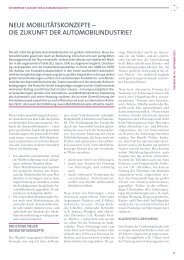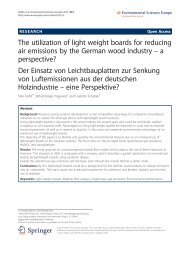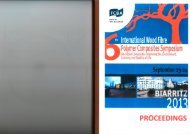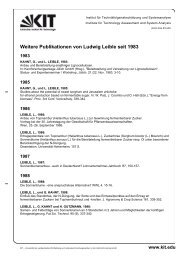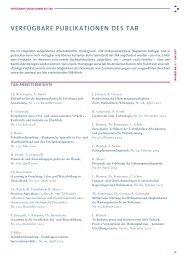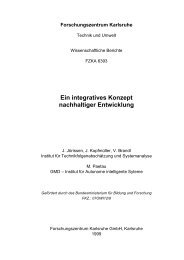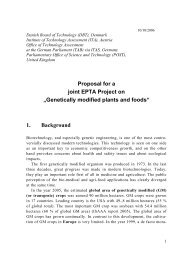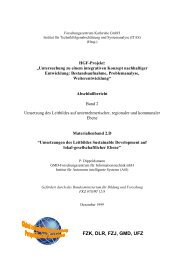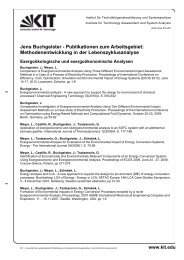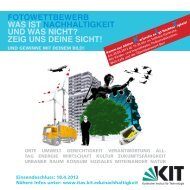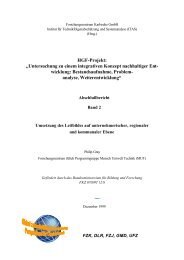Results: RFID and Identity Management in everyday life - ITAS
Results: RFID and Identity Management in everyday life - ITAS
Results: RFID and Identity Management in everyday life - ITAS
You also want an ePaper? Increase the reach of your titles
YUMPU automatically turns print PDFs into web optimized ePapers that Google loves.
Barcelona director Chase foresees a future <strong>in</strong> which everyone will have an <strong>RFID</strong> implant: “the<br />
objective of this technology is to br<strong>in</strong>g an ID system to a global level that will destroy the need to<br />
carry ID documents <strong>and</strong> credit cards. The VeriChip that we implant <strong>in</strong> the Baja will not only be for the<br />
Baja, but is also useful for whatever other enterprise that makes use of this technology.” One of the<br />
VIP guests of the Baja Beach Club Rotterdam, Steve van Soest agrees: 'The ma<strong>in</strong> benefit is that you<br />
can go out without hav<strong>in</strong>g to carry a wallet, which can get easily lost <strong>in</strong> a night club. […] It would be<br />
great if this catches on <strong>and</strong> you could put all your personal details <strong>and</strong> medical records on it. If I was<br />
<strong>in</strong>volved <strong>in</strong> an accident, doctors could simply scan me <strong>and</strong> f<strong>in</strong>d out my blood group <strong>and</strong> any allergies.'<br />
The director of the Rotterdam club, Jo van Galen, has a more reserved view on the application. He<br />
recognises the multiple opportunities the technology has, but is cautious about exp<strong>and</strong><strong>in</strong>g the<br />
applications of the chip. His ma<strong>in</strong> concern is runn<strong>in</strong>g a bus<strong>in</strong>ess, while the Dutch society <strong>and</strong> media<br />
tend to portray the Verichip <strong>in</strong> a negative manner. Consequently Mr. Van Galen is very much aware<br />
that op<strong>in</strong>ions on the technology can change easily from positive to negative <strong>and</strong> that this can harm the<br />
nightclub’s image.<br />
Still, Van Galen foresees some future applications too. Such as chipp<strong>in</strong>g personnel. Currently,<br />
personnel of the nightclub carry tokens with chips <strong>in</strong> them. This way they can enter through a<br />
personnel entrance. However, the token could be transferred to another person. The implant could<br />
have a big advantage there, s<strong>in</strong>ce it cannot be transferred nor lost be the carrier. But it should not, as<br />
we have seen on the section on work<strong>in</strong>g environments, be used for time-registration. Mr. Van Galen<br />
also th<strong>in</strong>ks about us<strong>in</strong>g a credit system <strong>in</strong> stead of the current debit system. This will <strong>in</strong>volve l<strong>in</strong>k<strong>in</strong>g<br />
the ID of the chip directly to a bank account or credit card. An advantage could be that a guest would<br />
never have to h<strong>and</strong> over any cash or bankcard <strong>and</strong> may enhance the feel<strong>in</strong>g of exclusiveness. A<br />
disadvantage could be that it does not ‘protect’ a guest from spend<strong>in</strong>g more than <strong>in</strong>tended, s<strong>in</strong>ce there<br />
is no maximum amount to spend. Furthermore, it <strong>in</strong>volves issues of privacy <strong>and</strong> safety. F<strong>in</strong>ally Van<br />
Galen is <strong>in</strong> favour of the application exp<strong>and</strong><strong>in</strong>g to other nightclubs. He envisions a ‘chipperscommunity’<br />
<strong>in</strong> which VIP Chip carriers from different nightclubs can meet (<strong>in</strong> person or virtual) <strong>and</strong><br />
<strong>in</strong> which they can use their status <strong>in</strong> associated clubs. For now, the chipp<strong>in</strong>g community will rema<strong>in</strong><br />
<strong>in</strong>side the Baja Beachclub until the negative storm of publicity surround<strong>in</strong>g the chip has settled down.<br />
Cross<strong>in</strong>g Borders: automat<strong>in</strong>g recognition<br />
Cont<strong>in</strong>u<strong>in</strong>g our travel, we will now take a plane from Amsterdam to Paris. At check<strong>in</strong>g <strong>in</strong>, two <strong>RFID</strong><br />
chips are manag<strong>in</strong>g our identity: one to track our luggage <strong>and</strong> one to prove we are who we claim to be.<br />
The first one is easy from our po<strong>in</strong>t of view: <strong>in</strong> stead of a bar code strip, the hostess connects an <strong>RFID</strong><br />
to our bag. From the perspective of the owner of this sett<strong>in</strong>g, the new system is a massive operation<br />
which will make luggage h<strong>and</strong>l<strong>in</strong>g faster <strong>and</strong> easier. The second application, our <strong>RFID</strong> passport is<br />
perhaps the most complex <strong>Identity</strong> <strong>Management</strong> operations <strong>in</strong> the history of <strong>RFID</strong>. The chip does not<br />
only store a unique number, but also picture of us. In the future, f<strong>in</strong>gerpr<strong>in</strong>ts will be added. In order to<br />
secure only the legitimate owner of the <strong>RFID</strong> environment can read the chip, many complex security<br />
measures need to be taken.<br />
In 2004 the the International Air Transport Association (IATA) launched a programme to test <strong>and</strong><br />
build a bus<strong>in</strong>ess case for the use of <strong>RFID</strong> for luggage management. In November 2005 the<br />
organisation <strong>in</strong>troduced a global st<strong>and</strong>ard for <strong>RFID</strong> baggage tags. Air France-KLM luggage<br />
h<strong>and</strong>l<strong>in</strong>g [case #15] serves as a test site on flights between Paris-Charles de Gaulle <strong>and</strong> Amsterdam<br />
Schiphol Airport. Later <strong>in</strong> 2006 more drop-off po<strong>in</strong>ts <strong>in</strong> Amsterdam Schiphol Airport will be us<strong>in</strong>g<br />
<strong>RFID</strong> labels. The goal of the pilot is to improve the baggage h<strong>and</strong>l<strong>in</strong>g process. By implement<strong>in</strong>g <strong>RFID</strong><br />
labels more read<strong>in</strong>g po<strong>in</strong>ts are possible, due to automated reads <strong>and</strong> a higher read rate than bar codes.<br />
Thus, bags can be sorted <strong>and</strong> loaded faster than bar code systems <strong>and</strong> the number of mish<strong>and</strong>led bags<br />
<strong>and</strong> associated costs is reduced. For now, the pilot looks promis<strong>in</strong>g from the po<strong>in</strong>t of view of <strong>Identity</strong><br />
<strong>Management</strong>. Bags can be identified easier, while the code can also be changed, for example when a<br />
flight direction is changed. From the perspective of the traveller, one may suggest this new system<br />
25



